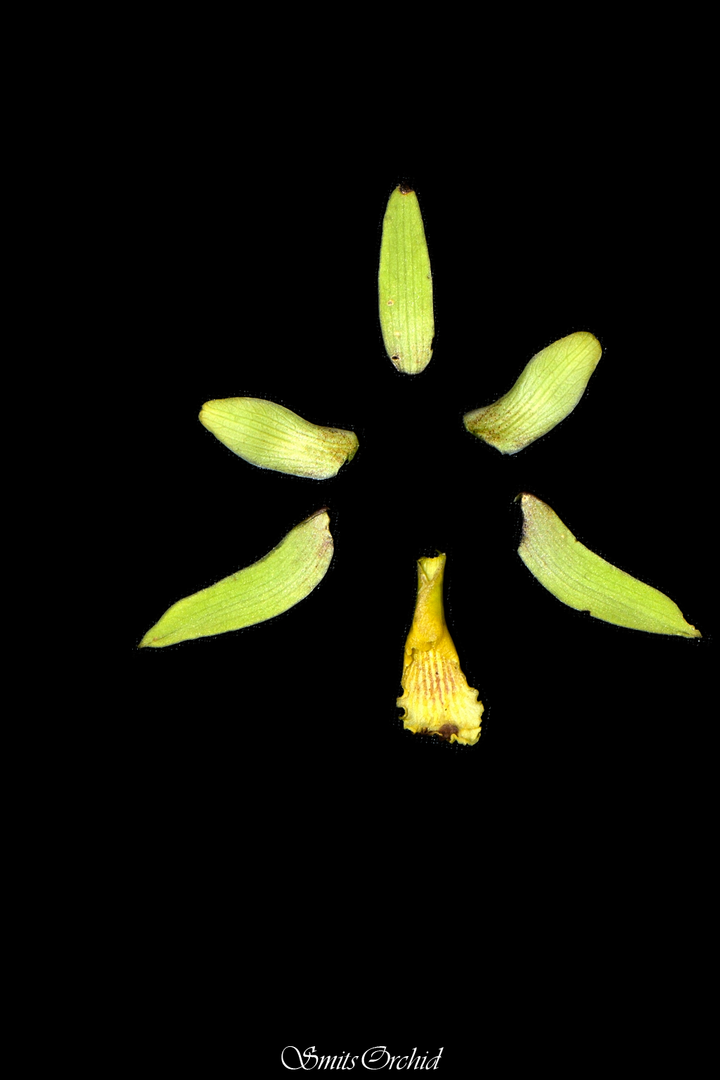
Eulophia R. Br.
Sub Family: Epidendroideae
Tribe: Cymbidieae
Sub tribe: Eulophiinae
Salient features:
-
Terrestrial less commonly lithophytic herb; Holomycotrophic or herteromycotrophic;
-
Roots basal often with well developed white velamen tissue
-
Perrenating organ stem like or pseudobulbous if above ground rhizomatus or tuberous, if subterranean cylindrical, fusiform, conical or ovoid, homoblstic;
-
Leaves linear lanceolate ovate or elliptic, acute or acuminate, coriaceous, articulate or not, sheathing bases rarely scale like lacking chlorophyll in holomycotrophic species
-
Inflorescence lateral simple rarely branched, bracts persisitant
-
Flowers: Green brown Purple to coloured occasionally bicoloured
-
Dorsal sepal oblong elliptic lanceolate or oblanceolate reflexed erect or prorrect; Lateral sepals oblique at the base & decurrent on column foot otherwise similar to dorsal sepal
-
Petals free similar or dissimilar to sepals often longer broader and distimctively coloured than sepals
-
Labellum free to the base or fused with the base of column, trilobed, spurred at the base, lateral lobes free or fused to the base of column, mid lobe flat or convex, Callus two or three ridged pr papillose; Pollinia two globose, stipe solitary triangular to oblong, Viscidium oblong, elliptic to lunate, ovary cylindrical grooved
-
Derivation of Name: from the Greek Eu good or true, lophus: plume referance to the callus on the lip or habit of type species
-
Eulophia Section Crytopera

Eulophia nuda Lindl.
-
Cyrtopera nuda (Lindl.) Rchb.f. in Flora 55: 274 (1872)
-
Eulophia spectabilis Suresh in D.H.Nicolson, C.R.Suresh & K.S.Manilal, Interpr. Van Rheede's Hort. Malab.: 300 (1988), nom. superfl.
-
Graphorkis nuda (Lindl.) Kuntze in Revis. Gen. Pl. 2: 662 (1891)
-
Cyrtopera fusca Wight in Icon. Pl. Ind. Orient. 5: t. 1690 (1851)
-
Cyrtopera gardneri Thwaites in Enum. Pl. Zeyl.: 302 (1861)
-
Cyrtopera godefroyi Rchb.f. in Otia Bot. Hamburg.: 35 (1878)
-
Cyrtopera laxiflora Gardner ex Thwaites in Enum. Pl. Zeyl.: 302 (1861)
-
Cyrtopera mysorensis Lindl. in J. Proc. Linn. Soc., Bot. 3: 32 (1858)
-
Cyrtopera plicata Lindl. in Gen. Sp. Orchid. Pl.: 190 (1833)
-
Cyrtopera regnieri Rchb.f. in Gard. Chron., n.s., 26: 294 (1886)
-
Cyrtopera squalida (Lindl.) Rchb.f. in Bonplandia (Hannover) 5: 38 (1857)
-
Cyrtopodium regnieri (Rchb.f.) Mottet in Dict. Prat. Hort. 2: 138 (1893-1894)
-
Cyrtopodium squalidum (Lindl.) S.Vidal in Phan. Cuming. Philipp.: 79, 150 (1885)
-
Eulophia bicolor Dalzell in Hooker's J. Bot. Kew Gard. Misc. 3: 343 (1851)
-
Eulophia bicolor var. celebica J.J.Sm. in Bull. Jard. Bot. Buitenzorg, sér. 3, 5: 71 (1922)
-
Eulophia burkei Rolfe ex Downie in Bull. Misc. Inform. Kew 1925: 380 (1925)
-
Eulophia celebica Blume in Coll. Orchid.: 182 (1859)
-
Eulophia elata Hook.f. in Fl. Brit. India 6: 3 (1890)
-
Eulophia elongata Blume in Coll. Orchid.: 182 (1859)
-
Eulophia fusca (Wight) Blume in Coll. Orchid.: 182 (1859)
-
Eulophia hildebrandii Schltr. in Repert. Spec. Nov. Regni Veg. Beih. 4: 262 (1919)
-
Eulophia holochila Collett & Hemsl. in J. Linn. Soc., Bot. 28: 132 (1890)
-
Eulophia lutea Blume in Coll. Orchid.: 181 (1859)
-
Eulophia macgregorii Ames in Philipp. J. Sci., C 9: 12 (1914)
-
Eulophia mucronata Blume in Coll. Orchid.: 182 (1859)
-
Eulophia regnieri (Rchb.f.) Guillaumin in Bull. Mus. Natl. Hist. Nat., sér. 2, 27: 395 (1955), nom. illeg.
-
Eulophia squalida Lindl. in Edwards's Bot. Reg. 27(Misc.): 77 (1841)
-
Eulophia squalida var. neoguineensis Schltr. in Repert. Spec. Nov. Regni Veg. Beih. 1: 418 (1912)
-
Eulophia sumatrana Blume in Coll. Orchid.: 183 (1859)
-
Geodorum pierrei Gagnep. in Bull. Mus. Natl. Hist. Nat., sér. 2, 4: 712 (1932)
-
Graphorkis elata (Hook.f.) Kuntze in Revis. Gen. Pl. 2: 662 (1891)
-
Graphorkis holochila (Collett & Hemsl.) Kuntze in Revis. Gen. Pl. 2: 662 (1891)
-
Graphorkis squalida (Lindl.) Kuntze in Revis. Gen. Pl. 2: 662 (1891)
-
Graphorkis sumatrana (Blume) Kuntze in Revis. Gen. Pl. 2: 662 (1891)
-
Phaius steppicola Hand.-Mazz. in Anz. Akad. Wiss. Wien, Math.-Naturwiss. Kl. 62: 253 (1925)
-
Semiphajus chevalieri Gagnep. in Bull. Mus. Natl. Hist. Nat., sér. 2, 4: 598 (1932)
-
Wolfia spectabilis Dennst. in Schlüssel Hortus Malab.: 38 (1818), genus not validly publ.

Ecology: It grows among bushes at the margin of evergreen & semi evergreen forest on porous soil

Tubers spherical brownish green, 6 cm or more in" diam.. with transverse ridges .. Leaves from the side of the tuber forming a short pseudostem from which the inflorescence is given out
Leaves 60x6mm lanceolate, acute, entire, plicate, many-nerved.

Inflorescence about 50 cm tall, the Peduncles with a few oblong-Ianceolate, many nerved sheaths.

Flowers 4.5 cm across, in lax racemes Bracts 2.4 X 0.3 cm, pale yellowish green, lanceolate, acuminate, entire.

Sepals 2.8 X 0.6 cm, spreading, subequal, deep mauve-brown on the outside, paler and brownish on the inside, faintly yellowish at the tips, lanceolate, acute, entrie, many-nerved; dorsal sepal 2.4x0.6cm oblong ovate the lateral sepals 2.8x0.6cm falcate and attached to the foot of the column.

Petals 2.4 X 0.9 cm, narrow, ovate-oblong, obtuse, entire, many-nerved, lying together over the column only the apices being slightly turned upwards; their colour is white or whitish flushed with rose-purple, the colour more prominent towards the base and on the midnerve.

Lip 3-lobed, rose-purple 2.4 cm long, 1.6 cm broad across the lateral lobes ; lateral lobes erect, small, 3 mm broad '; midlobe oblong, suborbicular, emarginate, crenate, crisped, 12 mm broad ; disc of the lip with 8-10 nerves which become crisped on the lobe.

Column 7 X 4 mm, rose-purple, foot 5 mm long. Spur brown-mauve, 6 X 4 mm, projecting below between the 2 arms of the foot, obconical retuse.

Anther 4 X 2.5 mm, broadly triangular-conical mauve, with 2 deep mauve bosses on the anterior face; pollinia 2, ovoid-oblong, yellow, waxy, with a very short caudicle and a small narrow gland

Ovary with pedicel 2.6 cm long, twisted, ribbed.
Capsule: 3cm greenish brown ribbed
Flowering: May -June
Fruiting: June






















